Lecture on TCM Diagnosis Chapter Two: Pathogenic Diagnosis
Section One: Diagnosis of the Six Excesses – Lecture 9: Wind Pathogenic Factors
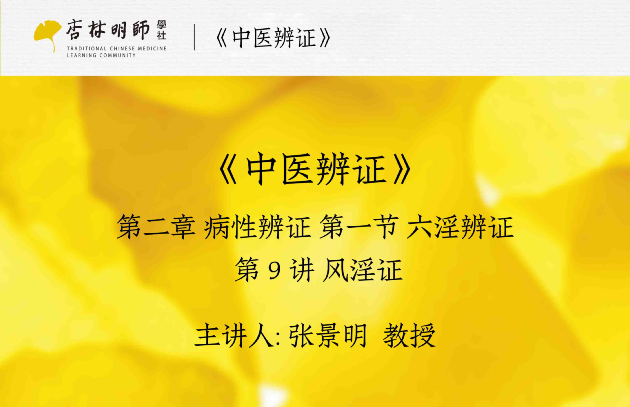
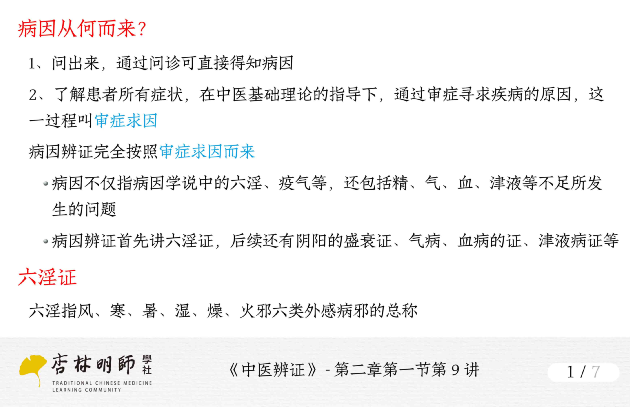
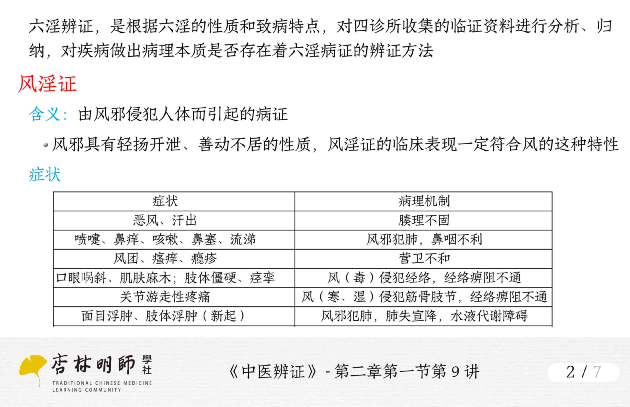
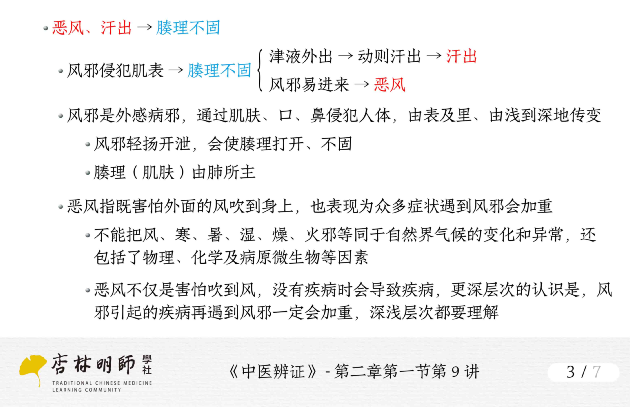
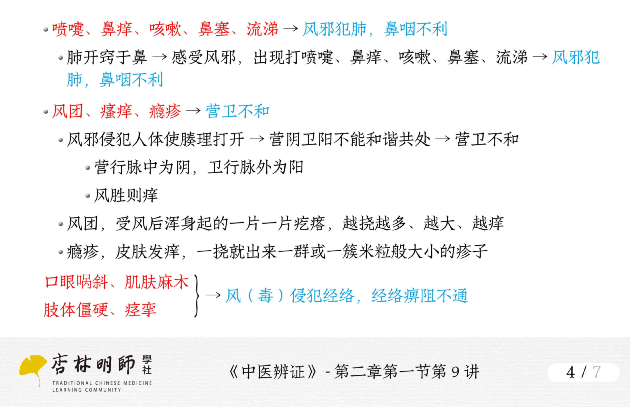
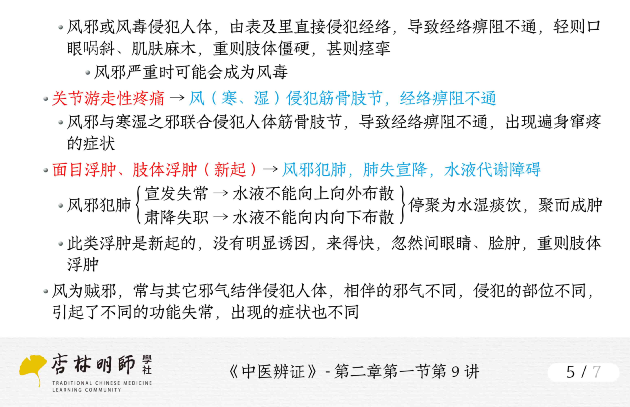
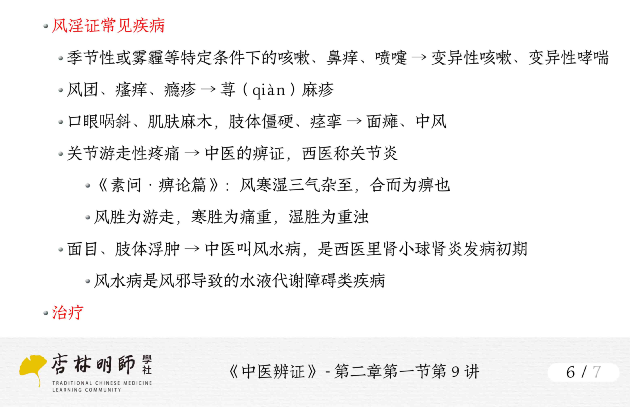
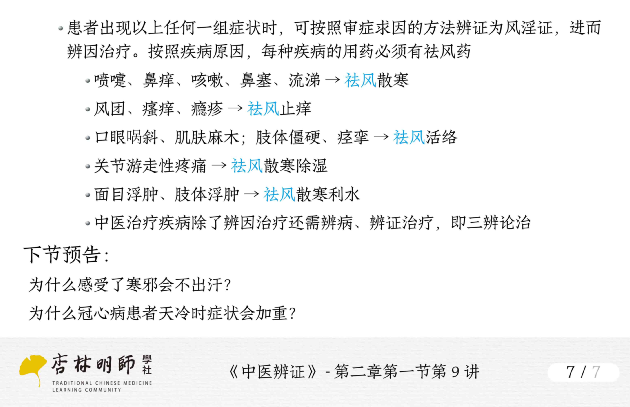
Question: What is the diagnosis of the Six Excesses?
Answer: The Six Excesses include Wind (Feng), Cold (Han), Heat (Shu), Dampness (Shi), Dryness (Zao), and Fire (Huo). The diagnosis of the Six Excesses refers to the method of analyzing and summarizing the data collected from the four examinations to determine whether the pathological essence of the disease is related to the Six Excesses. For example, urticaria caused by Wind is diagnosed as Wind Pathogenic Factors.
Question: What are Wind Pathogenic Factors?
Answer: Conditions caused by Wind evil, characterized by the properties of Wind: it moves easily and does not stay, and it is light and disperses.
Clinical symptoms: aversion to wind, sweating, thin white tongue coating, floating and slow pulse; nasal congestion with clear discharge, sneezing; or accompanied by throat itching and pain, cough; or sudden appearance of wind wheals, skin itching, urticaria; or sudden numbness of the skin, facial drooping; or muscle stiffness, spasms, convulsions; or wandering pain in limbs and joints; or swelling of eyelids, face, and limbs.
Question: How to understand the disharmony of Ying and Wei?
Answer: Wei refers to the defensive Yang Qi at the body surface, while Ying is the basis of sweat fluid. Disharmony of Ying and Wei generally refers to the pathological condition of exterior syndrome with spontaneous sweating.
There are two situations of spontaneous sweating in exterior syndrome:
One is “Wei weak, Ying strong.” Due to the weakness of the Yang Qi at the surface, it loses its ability to secure the exterior, leading to spontaneous sweating without fever.
The other is “Wei strong, Ying weak,” where Yang Qi is constrained at the surface, forcing Ying Yin inward, resulting in spontaneous sweating during fever, but no sweating when there is no fever.
Strength and weakness are relative; the treatment method is to use Gui Zhi Tang (Cinnamon Twig Decoction) to support the righteous Qi and expel the evil, harmonizing Ying and Wei. However, the timing of taking the medicine should differ: for spontaneous sweating during fever, it should be taken before the fever; for spontaneous sweating without fever, the timing is not restricted.
Additionally, Wei Qi moves in Yang during the day, and when Yang is abundant, it is active and excitable, hence the energy is abundant during the day; at night, Wei Qi enters Ying Yin and moves in Yin, which is characterized by stillness and inhibition, leading to good sleep at night. If Qi and blood are deficient, and Ying and Wei are not harmonized, Wei Qi does not move in Yang during the day and does not move in Yin at night, resulting in insufficient energy during the day and poor sleep at night, i.e., lack of energy during the day and insomnia at night.
Question: What is Wind Water Disease?
Answer: Wind Water is characterized by sudden localized edema, belonging to Yang Water and is considered a condition of excess, often caused by external Wind evil, sores, or dampness, with the disease location in the lungs and spleen.
Generally, Wind Water primarily manifests as: sudden onset, starting with eyelid edema, which then gradually develops into edema of the trunk and lower limbs. In comparison, Yang Water is easier to resolve and has a better prognosis.
Question: How to differentiate between stroke affecting the meridians and stroke affecting the organs?
Answer: The fundamental difference lies in:
Stroke affecting the meridians generally does not involve changes in consciousness, presenting as sudden facial drooping, slurred speech, and hemiplegia, without sudden loss of consciousness.
Stroke affecting the organs, however, presents with sudden loss of consciousness, unresponsiveness, hemiplegia, facial drooping, stiff tongue, slurred speech or inability to speak, numbness on one side, and confusion or stupor as the main symptoms, often leaving sequelae.
Stroke affecting the meridians has a shallower disease location and is milder; stroke affecting the organs has a deeper disease location and is more severe.
Question: How to understand “Wind is the leader of all diseases”?
Answer: “Wind is the leader of all diseases” means that Wind evil is a very important pathogenic factor for exogenous diseases and is a precursor to other external evils. This can be understood from the following aspects:
(1) Although Wind is the dominant Qi of spring, it is present throughout the year and in all seasons. While exogenous diseases caused by Wind are more common in spring, they can also occur in other seasons;
(2) Wind evil invades the body primarily through the skin and hair, and due to its characteristic of opening and dispersing, it easily loosens the skin and opens the pores, providing an entry point for other evils, leading to a type of exogenous disease caused by Wind combined with other evils, such as Wind-Cold, Wind-Heat, and Wind-Damp;
(3) Because Wind is characterized by movement and change, when Wind evil invades the body, the range of diseases is broad and diverse.
Thus, it can be seen that Wind evil is the most common among the Six Excesses, and ancient practitioners even referred to Wind evil as a general term for exogenous pathogenic factors. Therefore, the “Su Wen” states, “Wind is the beginning of all diseases” and the “Su Wen: Bone Hollow Theory” also states, “Wind is the leader of all diseases.”
Question: How to understand “Wind is characterized by movement and change”?
Answer:(1) Movement refers to the characteristic of Wind evil to cause diseases that have a migratory nature, with no fixed location, such as the pain of joints that moves unpredictably.
(2) Change refers to the characteristic of Wind evil to cause diseases that are unpredictable and develop rapidly, such as the sudden onset of Wind rash, which can appear and disappear without a fixed location.
Question: Why does Wind evil have the characteristics of being mobile and dispersive?
Answer: In TCM, there is a method of analogy; the Wind in nature has a dynamic and non-stationary characteristic, hence ancient practitioners referred to a class of pathogenic factors that exhibit similar characteristics to Wind as Wind evil, which is not a single pathogenic factor but a general term for a class of pathogenic factors.
Therefore, Wind evil possesses characteristics similar to Wind, being mobile and dispersive.
Dispersive: it causes the pores to open and disperse.
Question: Is “Wind evil” caused by “excessive Wind”?
Answer: “Wind evil” is not caused by “excessive Wind”; rather, it is a natural pathogenic factor that, upon invading the human body, leads to symptoms that are “wandering and unpredictable like Wind.”
Question: How to distinguish between external Wind and internal Wind?
External Wind generally enters through the skin and meridians, causing external evils, leading to disharmony of Ying and Wei, and lung Qi dysfunction, with different clinical manifestations such as aversion to cold, fever, sweating, aversion to wind, cough, throat discomfort, skin itching, and floating pulse.
Internal Wind arises from internal dysfunction of the organs, with Qi and blood in disorder, such as excessive heat, Yang hyperactivity, Yin deficiency, or blood deficiency, leading to symptoms resembling Wind movement, primarily characterized by dizziness, limb numbness, tremors, and convulsions.
Question: What are the types of internal Wind?
Answer:(1) Liver Yang transforming into Wind, due to Liver Yin deficiency, Yang hyperactivity, and floating Yang disturbing, forming a Wind-like movement.
(2) Extreme heat generating Wind, referring to a pathological state where excessive heat injures the Liver tendons, leading to Wind-like characteristics.
(3) Yin deficiency causing Wind movement, referring to a pathological state where Liver and Kidney Yin deficiency leads to insufficient nourishment of tendons and vessels, resulting in Wind-like movement.
(4) Blood deficiency generating Wind, which refers to a pathological state where blood deficiency fails to nourish tendons and vessels, leading to symptoms like limb numbness, muscle twitching, or tremors resembling Wind movement.
(5) Blood dryness generating Wind, referring to a pathological state where blood deficiency and fluid loss lead to dryness, causing insufficient nourishment of the skin and resulting in Wind-like movement.

